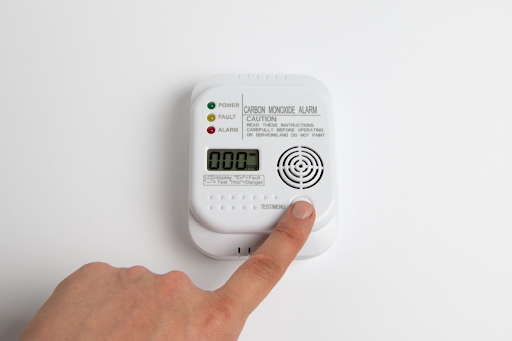At Magnify Electric, we take electrical safety very seriously. After all, a properly functioning electrical system is the backbone of a comfortable and secure home. But electrical safety goes beyond just faulty wiring and flickering lights. It also encompasses potential hazards from byproducts like carbon monoxide (CO). That’s why we believe every homeowner should be equipped with knowledge about carbon monoxide detectors and their optimal placement.
In this comprehensive guide, we will explore the optimal placement of carbon monoxide detectors, highlight the dangers of carbon monoxide poisoning, and explain why it is essential to have these devices installed correctly. To learn more about carbon monoxide or our electrical services, do not hesitate to reach out. From installations to maintenance and electrical repairs, we keep Austin powered up and informed on how to avoid unexpected sparks.
Carbon Monoxide Detectors vs. Smoke Alarms
While both carbon monoxide detectors and smoke alarms are essential for home safety, they serve different purposes and detect different threats. Smoke alarms are designed to detect the presence of smoke, which is an indication of a fire. They use ionization or photoelectric technology to sense smoke particles in the air and alert homeowners to the danger of fire.
On the other hand, carbon monoxide detectors are specifically designed to detect the presence of carbon monoxide (CO), a colorless, odorless, and tasteless gas that can be deadly. Carbon monoxide detectors use electrochemical sensors to identify the presence of CO in the air and sound an alarm to warn occupants. Unlike smoke, carbon monoxide is not visible and cannot be detected by smell, making CO detectors crucial for protecting against this silent killer.
The Dangers of Carbon Monoxide Poisoning
Carbon monoxide poisoning is a serious and potentially fatal condition that occurs when CO gas builds up in enclosed spaces. CO is produced by the incomplete combustion of fossil fuels such as natural gas, oil, coal, wood, and gasoline. Common sources of carbon monoxide in homes include gas furnaces, water heaters, stoves, fireplaces, and car engines.
When inhaled, carbon monoxide binds to hemoglobin in the blood, preventing it from carrying oxygen to the body’s tissues and organs. Symptoms of carbon monoxide poisoning can range from mild to severe and include headaches, dizziness, nausea, confusion, and loss of consciousness. Prolonged exposure to high levels of CO can lead to brain damage and death. Because carbon monoxide is invisible and odorless, it can accumulate without any warning, making it vital to have functioning CO detectors in your home.
Finding the Best Placement for Your CO Detector
Determining the correct placement for carbon monoxide alarms is the secret to maximizing their effectiveness. According to the National Fire Protection Association (NFPA), CO detectors should be installed in several key locations throughout your home for comprehensive coverage.
Near Sleeping Areas
The most critical placement for carbon monoxide detectors is near sleeping areas so that the alarm will wake you up if CO levels become dangerous while you are asleep. Ideally, a CO detector should be placed within 15 feet of each bedroom door. If your home has multiple sleeping areas separated by significant distances, it is advisable to install additional detectors to cover each area adequately.
On Every Level of the Home
To provide the best protection, a carbon monoxide detector should be installed on every level of your home, including the basement and attic, if applicable. This is particularly important if your home uses fuel-burning appliances on different levels, as CO can accumulate in various locations. For instance, a gas furnace in the basement may leak CO that rises to the upper floors.
Adjacent to Fuel-Burning Appliances
Install carbon monoxide alarms near any fuel-burning appliances, such as furnaces, water heaters, fireplaces, and gas stoves. These appliances are common sources of CO leaks, and placing detectors nearby can quickly alert you to any malfunctions or improper ventilation. Ensure that detectors are placed at least five feet away from the appliances to avoid false alarms due to normal emissions during startup.
Near Attached Garages
If your home has an attached garage, place a CO detector in the room adjacent to the garage. This helps to detect any CO that may seep into your home from vehicles left running inside the garage, a common cause of carbon monoxide poisoning.
Avoiding Humid Areas
Avoid placing carbon monoxide detectors in humid areas such as bathrooms or laundry rooms. High humidity and steam can interfere with the sensor’s accuracy, leading to false alarms or reduced sensitivity.
How Magnify Electric Can Assist With Your CO Alarm
At Magnify Electric, we offer professional installation services for both carbon monoxide and smoke detectors so they are placed correctly and function as intended. Our team of experienced electricians can assess your home’s layout, identify potential sources of CO, and recommend the best locations for installing detectors. Additionally, we provide regular maintenance and inspection services to keep your detectors in perfect working condition.
Contact Us Today and Keep Carbon Monoxide at Bay
Feel free to contact us for more information or to schedule a consultation regarding your carbon monoxide alarm. Your safety is our priority, and we are here to make certain that your home remains a secure and healthy environment. Reach out today to take the next step in protecting your home and loved ones.

